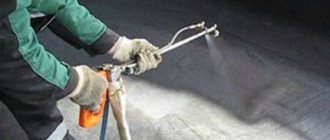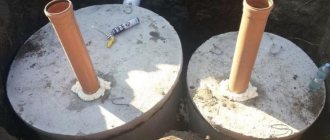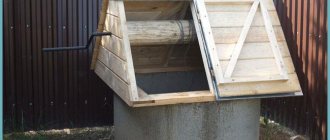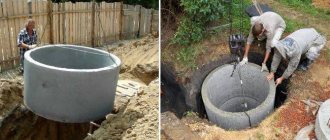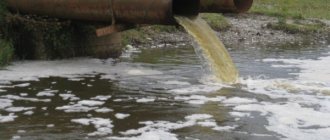In the process of building a private house, one of the important points is: arrangement of the sewer system. Not so long ago, for many people, the concept of “sewage” was equated with the concept of “cesspool”, but today there are several solutions for arranging sewerage. Septic tank is one of them. You can use a well-known or “Tank” brand of septic tank, but a more economical option is a septic tank made of reinforced concrete rings. Here you will learn about how a septic tank is built from concrete rings, the principle of operation and much more.
Principle of operation
Let's start with the fact that there are two types of septic tanks: two-chamber and multi-chamber. The two-chamber one is the simplest in design. Its components: a settling tank, where a three-day process of separating wastewater into liquid and solid waste takes place; a filter well without a sealed bottom, into which purified water flows from the sump and goes into the ground. In order for the filter well to be less polluted and the quality of water purification to be better, several settling tanks can be combined into a sequential chain.
A multi-chamber septic tank is different in that when used, the degree of wastewater purification is much higher, and removing sediment from it is faster and more convenient. But it is important to know that even a ten-day septic tank will not completely clean the wastewater, since the bulk of the sediment is in the 1st section, without re-contaminating the water with waste products.
Construction options
The design of a septic tank made of concrete rings is not complicated. It can be a two- or three-chamber structure. Single-chamber storage tanks operating on the principle of cesspools are used much less frequently.
The number of storage and filtration tanks in such a treatment facility, depending on the volume of liquid processing, can be two or three
Regardless of the type of design of the structure, when servicing it, it will be necessary to involve sewage equipment. It will remove solid waste that accumulates on the bottom and walls of storage tanks.
Single-chamber septic tanks are chosen when designing a sewer system for small-area country houses for seasonal residence, provided that the volume of wastewater is small. Good reasons for installing a single-chamber storage tank also include the high groundwater level and the predominance of clayey rocks in the geological section of the site.
Two- and three-chamber structures are installed when laying autonomous sewers for cottages intended for year-round living with large volumes of wastewater.
The most optimal option for a local treatment plant is the installation of a septic tank, which includes two tanks
When arranging a two-chamber structure, supplemented by a filter well or filtration field, the first compartment is a sealed container with a limited supply of oxygen.
It is equipped with a cast iron or concrete hatch, as well as an inlet and outlet for drains. The second compartment is equipped with a ventilation pipe to create conditions for oxygen access.
When constructing a purifier that includes two or three reservoirs, the wastewater will be subjected to multi-stage purification by sedimentation and filtration:
- In the first storage tank , the primary purification process is carried out, during which large suspended matter is deposited and, under conditions of lack of oxygen, decomposes, and organic matter is processed by anaerobic bacteria.
- In the second chamber , the purification and filtration process continues, but with the participation of oxygen and aerobic bacteria. The decomposed remains of organic matter in the form of sludge settle to the bottom, and the clarified liquid enters the drainage, also known as absorption or filtering, well.
The water that has undergone further purification flows into the drainage well, from where it goes into the ground through holes in the walls and passing through filtration through the sand and crushed stone layer.
The scheme of a septic tank made of rings includes two working chambers connected to each other by a thick overflow pipe, and the third column acts as a drainage well
If the land plot is located on soils with good filtration properties that absorb and pass water well, and the groundwater level is not high, it is worth considering the option of installing a septic tank, in which the clarified liquid is discharged into an absorption well.
In areas with a groundwater level reaching only 2.5 m, the process of ground purification is most often impossible, since there must be at least a meter between the lowest point of the drainage well and groundwater. In this case, it is better to discharge the wastewater treated by the septic tank to drainage fields.
The arrangement of such systems requires large square areas. But under given conditions, sometimes this is the only system that works.
Image gallery
Photo from
The principle of operation of septic tanks made of rings
Construction of an absorption well
Filtration field at high water surface
Drainage trenches for water disposal
In what cases is the construction of a septic tank prohibited?
There are several requirements for the site where the construction of a sewer system is planned, non-compliance with which is not allowed. We list the conditions under which it is impossible to build a septic tank:
- coverage of the sanitary protection zone of water supply sources;
- subsidence or rocky soil;
- steep slope (can lead to landslides);
- excessively high groundwater level;
- impossibility of maintaining sanitary, construction or technological gaps between buildings and soil filtration structures.
Frequently asked questions
During the construction of a septic tank, the same type of questions often arise, which are easier to answer in advance:
How to protect a septic tank from seasonal soil movements?
No one can give a 100% guarantee here. If the composition of the soil layers is replete with clay layers, it is necessary to take any measures to prevent frost heaving - make drainage, increase the backfill layer, insulate the bottom of the pit.
Will the septic tank freeze in winter?
Fermentation processes taking place in the chambers produce heat. In addition, the temperature of the wastewater, as a rule, is high enough to maintain the thermal regime in the chambers. Even in the northern regions, septic tanks are capable of supporting the vital activity of bacteria that cannot withstand negative water temperatures.
There is often advice online to locate overflows below the ground freezing level. How critical is this?
This rule applies only to regions with shallow freezing depth. In most regions with harsh climates, pipes are insulated by installing a foam shell, or by filling them with polystyrene foam granules.
If the rings are not equipped with a bottom, is it possible to install them on a concrete screed?
Can. This will require additional effort and time of pouring until structural strength is achieved. However, if there is no alternative, you have to fill the bottom yourself.
What reserve volume of a septic tank is best to set when performing calculations?
As a rule, they expect 2 more users to appear.
Which sewer pipes are best to use for overflows?
The best option is red PVC pipes. However, you can install asbestos-cement or cast iron pipes.
How to choose the right location for an overflow sewer on a site?
In accordance with the legislation of the Russian Federation, in order to avoid soil erosion by runoff water, the sanitary protection zone from the overflow sewer to a residential building must be 5 meters, and to the neighboring site - 4 meters.
If the construction of treatment facilities is planned on a garden plot, it is necessary to maintain a distance of 2 - 4 meters from trees, since the root system can damage the structure.
How to calculate the volume of a septic tank and the number of chambers?
On average, one person living in a private house produces 200 liters of wastewater per day. Let's take this indicator to calculate the volume of the septic tank. In order to make calculations for a specific family, you must first multiply the average waste rate by the number of family members, and then by three days of stay. For example, a family consists of five people, which means the calculation for a three-day stay will be as follows: 200 x 5 x 3 = 3 m3. If you remove sediment twice a year, the volume of the septic tank will decrease by 20%.
When assembling a treatment structure from standard reinforced concrete structures, you will need three such rings. The diameter is one and a half meters and the height is 0.9 meters. Also needed: 1 cover plate and 1 cast iron hatch.
The weight of one and a half meter reinforced concrete rings can exceed a ton, so to simplify work with the structure, rings with a smaller diameter can be used. And in order for the septic tank not to be too deep, it is necessary to build two containers, connecting them to each other. Thus, you will get a two-chamber septic tank. It is important to understand that the total working volume matters more than the number of cameras. To save money, you can get by with one camera.
Which rings to choose - with or without a lock?
Concrete rings with a lock (tongue-and-ridge connection) and without it are available on the market. There is an opinion that the former provide higher water resistance and better protect the septic tank structure from lateral movement.
However, according to experts, this is not true. In practice, there is no big difference between both types of rings in terms of water permeability. If there are such significant shifts in the soil during frost heaving that, in principle, they can displace one ring relative to another (the weight of one ring with a diameter of 1 m is 600 kg), then the lock will not save. As for the convenience of centering rings with a lock during installation, this is only true for a structure of two rings. In the case of a septic tank with three or more rings, the difference is unlikely to be noticeable.
How to prepare a pit?
When starting to prepare a pit, you should take into account the maximum permissible groundwater level. When installing filter wells, it must be at least 3 meters from the ground surface, when installing underground filtration fields and clay soils - 1.5 m.
When digging a hole for a future well, adhere to the principle: the soil moisture has increased at a decent depth - it’s time to finish. If the depth of the dug hole is less than 1 meter, then nothing will come of it and you will have to bury it.
In order to have good stability and prevent drainage of wastewater into the ground, the installation of a multi-chamber septic tank requires the fulfillment of the following conditions: all chambers, except the final one, must be installed on a concrete base.
External waste disposal system
Sewer rings are the main component of its outer part, performing the functions of containers for various purposes in a wastewater treatment system. Products used are walk-through, without a bottom and equipped with bottoms. In addition, covers in the form of concrete slabs with a passage opening for maintenance are a mandatory element. For filter wells, rings with perforated walls are also used, in which a bottom filter is installed.
The finished container is equipped with two lids - an inner wooden one and an outer plastic or cast iron one. Concrete sewerage products are immersed in the ground to a depth that ensures that only the top cover protrudes outward.
The advantages of using such products include the following properties:
- strength, allowing you not to fear damage when the soil freezes in winter;
- durability - high-quality products of standard quality can serve in the sewerage system for up to 50 years;
- ease of installation - do-it-yourself reinforced concrete sewerage is quite affordable for most performers;
- cost savings on purchasing rings compared to ready-made plastic containers.
The main disadvantage of concrete sewer systems is the large volume of excavation work, but this property is equally inherent in any external drainage and wastewater treatment systems.
How to install a sump tank?
Consider the installation of a two-chamber septic tank. In the pit, the bottom is filled with sand to a depth of 100-150 mm and watered for the best shrinkage.
The next concrete ring is installed on a solution in proportions - 1 cement: 3 sand: 0.1 liquid glass. It is necessary to prepare the solution in small portions, since it must be used within half an hour.
1 — rings of the working part; 2 — insulating cover; 3 — neck rings; 4 — hatch body; 5 — hatch cover; 6 — ventilation riser; 7 - floor slab; 8 — bottom plate; 9 — crushed stone cushion; 10 - waterproofing; 11—sediment zone; 12 — running brackets
The cover with the hatch is installed on a bed of sand-cement mortar.
The sump requires waterproofing with two layers of hot bitumen or coating with a water-repellent composition.
Ventilation
When installing a septic tank, ventilation is important, one might even say key. It is needed to eliminate unpleasant odors, which, in the absence of ventilation or its improper design, are very unfavorable not only from an aesthetic point of view, but also from a health point of view - breathing methane is harmful, even dangerous in large quantities. Another aspect is that ventilation does not allow the air to discharge. And most importantly, ventilation is needed to keep the entire system in working order.
The sewer drain pipe is connected to a ventilation riser, which should be led to the roof. The diameter of both channels - ventilation and sewer - should have the same diameter, for example, 110 mm (optimally). This will ensure the system functions correctly.
How to install a filter well?
An iron barrel is suitable as a filter well, which will save your budget.
The location of the filter base should be at a level exceeding 1 meter of groundwater level. Otherwise, the load goes up to 20%.
1 — water barrier; 2 — neck rings; 3 — hatch cover; 4 — insulating cover; 5 — hatch body; 6 - floor slab; 7 - ventilation riser; 8 — blind rings; 9 — perforated rings; 10 - filter media; 11 — holes in the rings; 12 — concrete base; 13 - supply pipeline
To increase the absorbent surface area, holes with a diameter of 60 mm and a total area of 10% need to be made on the walls of the well.
At the bottom you should lay out a layer (200-300 mm) of expanded clay, crushed stone and other small stones, which will serve as a filter.
We recommend reading the instructions for building a drainage well.
Dimensions of concrete rings for sewerage
Before installing concrete rings into the overall system, it is necessary to calculate the required volume of the tank and become familiar with the main dimensions of the products. The standard series of wall rings according to GOST 8020-90 is marked KS. For sewerage, KS15, KS20 are usually chosen. KS7 is used as the well neck (if necessary).
KS10 has a volume of 0.24 cubic meters with a maximum height of 89 centimeters. Three such rings will not be enough for one camera of any scheme, unless they are suitable for the second or third chamber of a three-chamber system, if a small family lives in the house.
KS13 is only 89 centimeters in height, but KS15 can be 59/89 centimeters. There is also KS25, but for them there are only floor slabs and no bottoms. Thus, KS15/20 rings are the most optimal choice for a system of good volume.
The bottoms can be like this:
- PN10 – diameter 150 centimeters
- PN15 – diameter 200 centimeters
- PN20 – diameter 250 centimeters
Floor slabs are available for all sizes of rings, with the exception of KS7 rings. All sizes and volumes can be viewed in the table.
The elements are selected in such a way that it is possible to obtain the required volume of tanks using 2-3 rings, since otherwise installation may be too labor-intensive and the number of seams will be large, which is undesirable.
How to install overflows?
The tray must be placed 100 mm higher than the filter. It supplies wastewater to the entire water supply system. Its open end should be in the center of the well.
The overflow should be laid with a slope of 2 cm per linear meter, which will reduce blockages.
The distance between the inlet and outlet pipes must be at least 50 mm. The first one will be located above. Please note that the use of plastic pipes for the external main leads to premature wear of the entire system.
To ensure that the water flow is directed downwards, the sewer tee must be installed in a vertical position.
Tees for overflows
In addition to the overflow holes, it is important to take care of the hole for the ventilation pipe.
Types of wells depending on functions
Where can concrete rings be used? When it comes to sewer wells, you need to understand that there are also, for example, inspection (or inspection) wells. They are located at the turning points of the pipeline through which wastewater is discharged from the house (read: “Sewer inspection well - design and installation options”). In addition, if such a pipeline is too long, then it also makes sense to install inspection wells every 10-15 meters.
This is done so that in the event of a blockage or stagnation in the pipe, it is possible to determine in which part of it it occurred. And as a result, quickly eliminate the problem. Types of sewer wells:
- Inspection
well (discussed a little higher). - Control
. In terms of its tasks, this well is very similar to the previous one. The difference is that it is built where pipes are combined into one, or there is a transition from a pipe with a larger diameter to a pipe with a smaller one. - Flushing
. Its function is to help clean the pipeline. It is placed at the highest section of the pipeline. - Rain
. They help collect water from heavy rains from roofs and the surface of the ground. - Sucks
. These wells are used where wastewater needs to be cleaned of solid sediments, where the wastewater is highly contaminated (for example, after production or the presence of a large amount of household waste in the wastewater). - Special
. They are installed in places where the sewer pipeline is connected to other main networks. - Drops
. These wells help dampen the flow of wastewater. This happens in those sections of the pipeline where there is a sharp downward slope (for example, due to landscape features).
